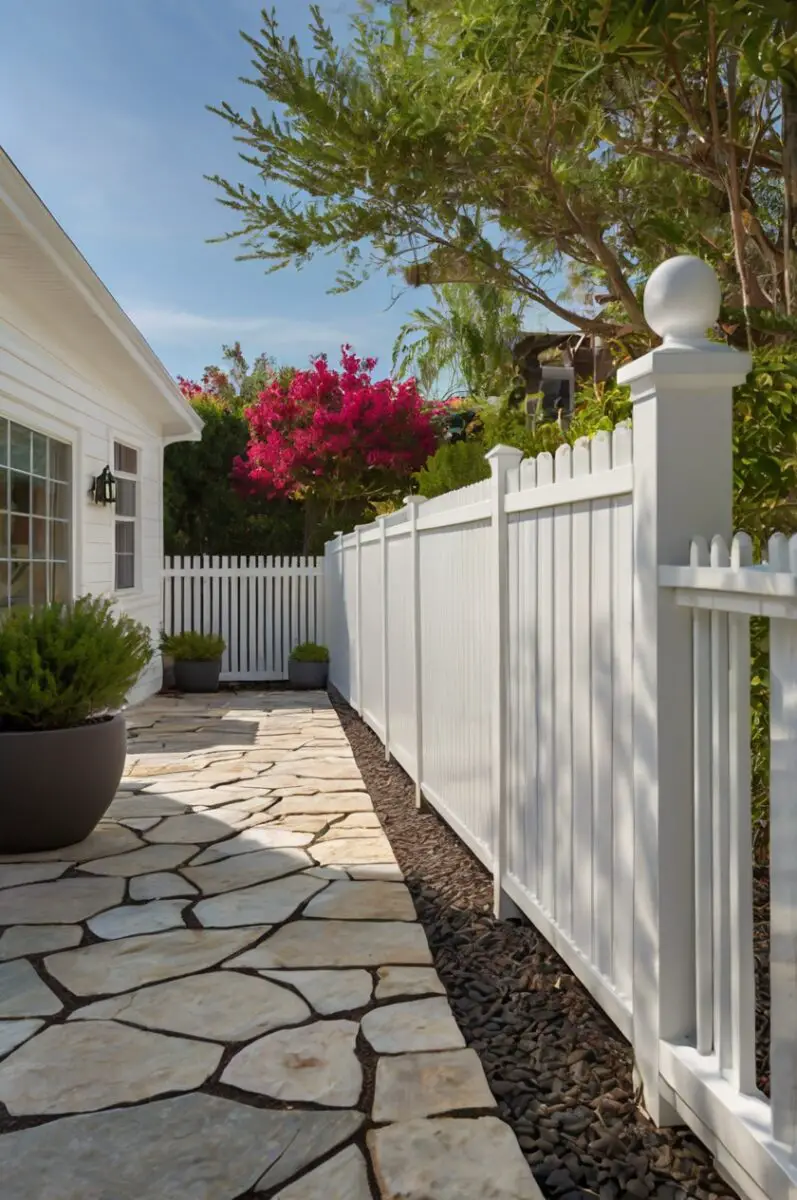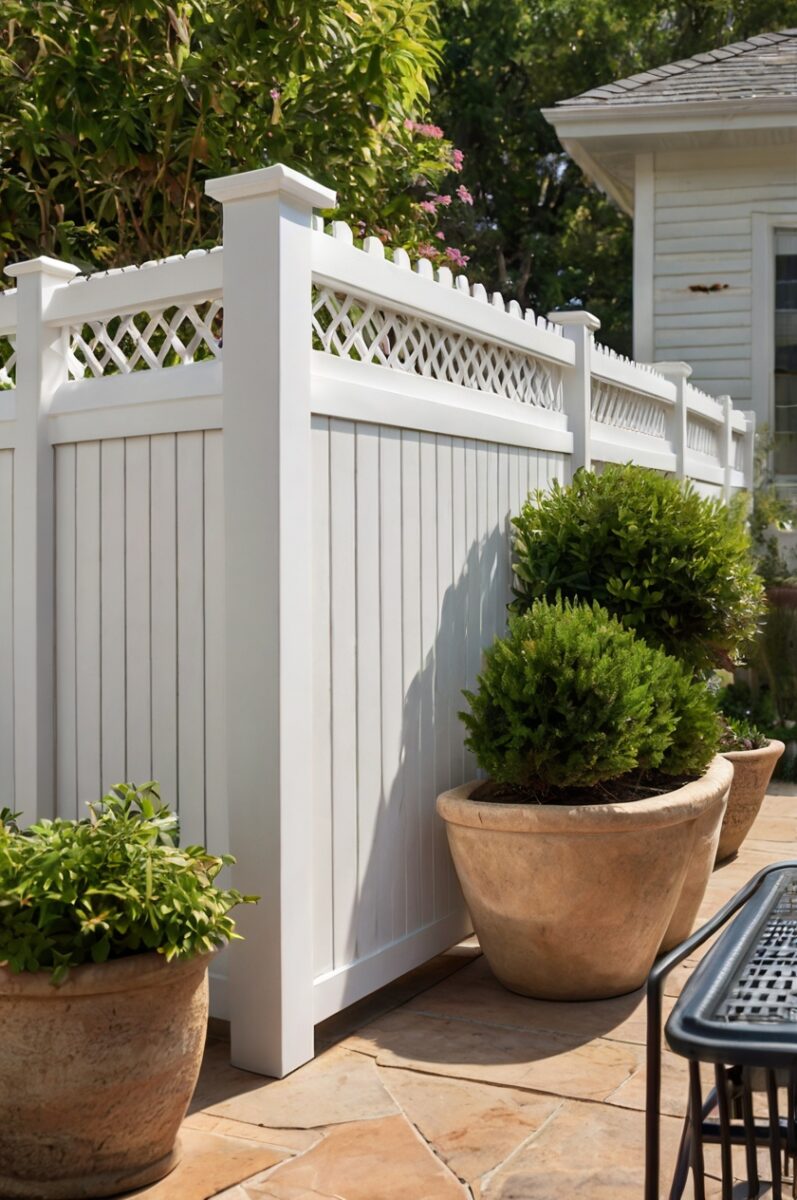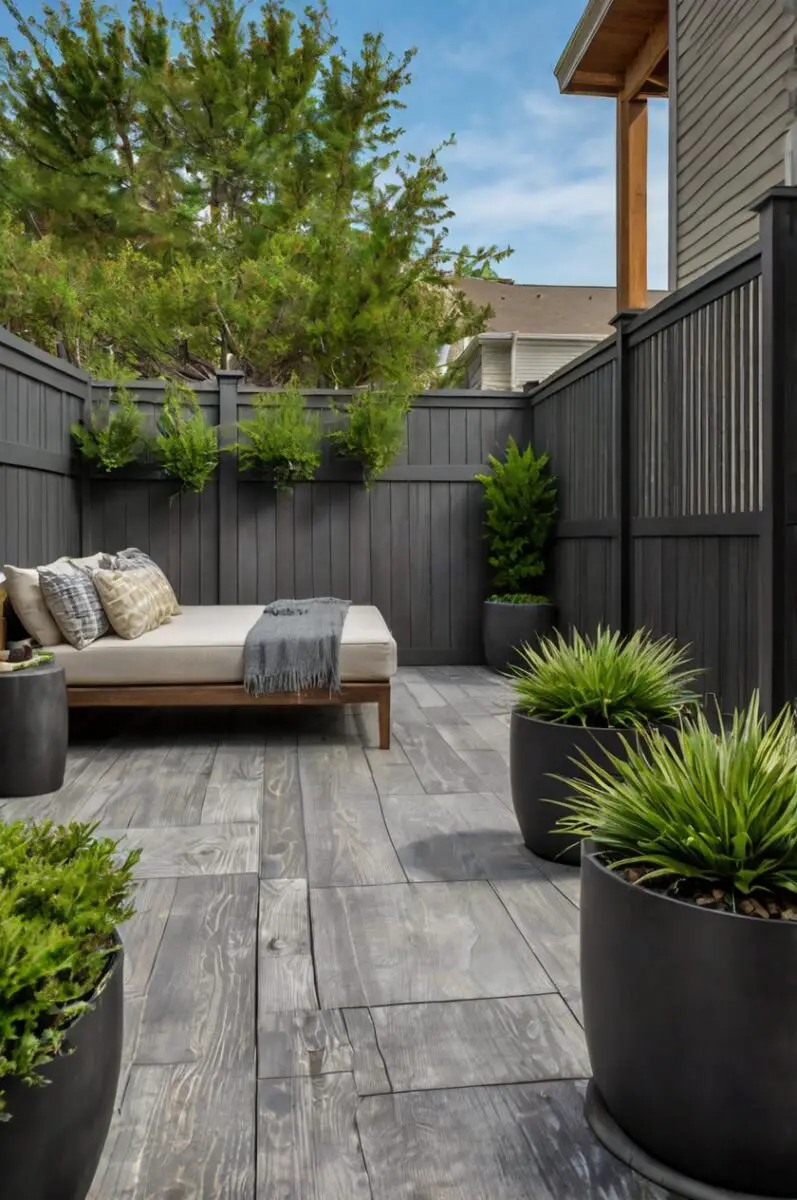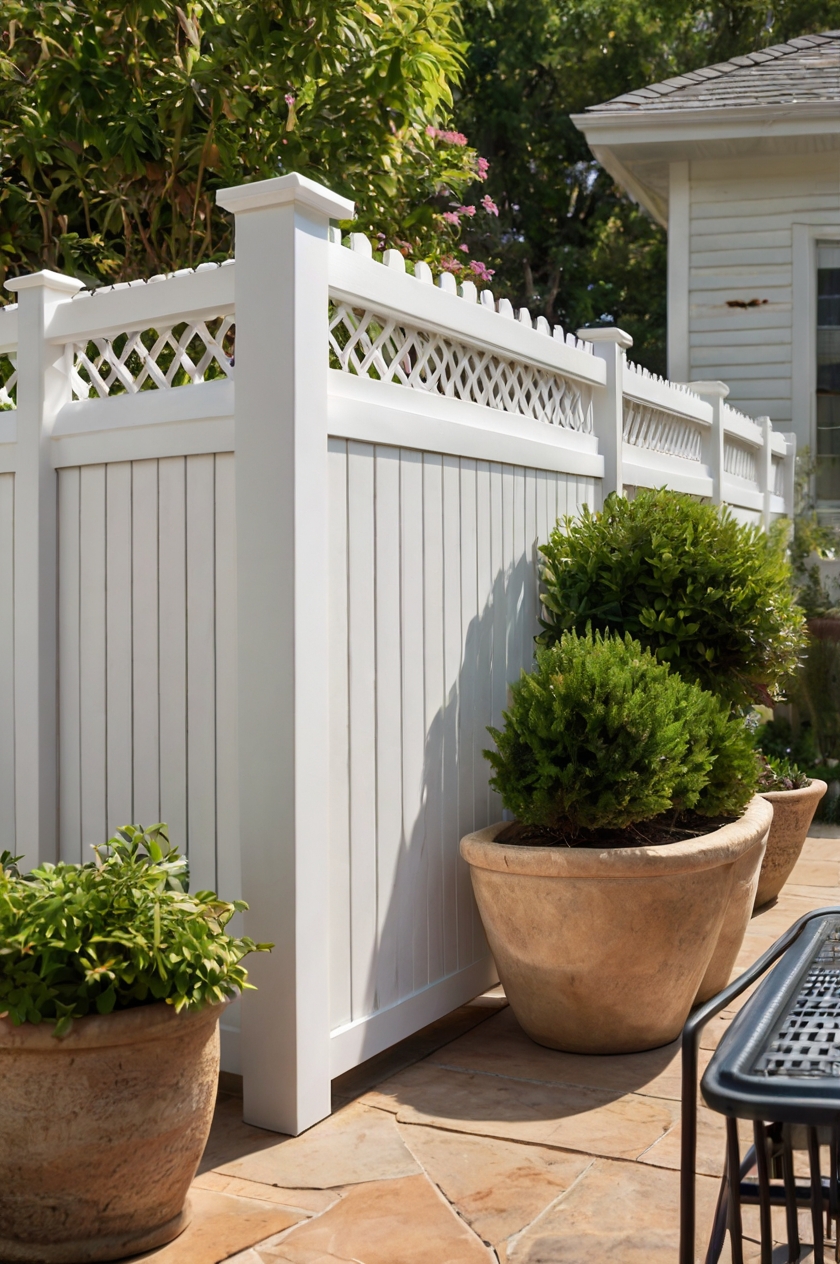Are you staring at that plain wood fence in your backyard and feeling uninspired?
It’s amazing how a simple coat of paint can completely change the look and feel of your outdoor space.
The right fence color can make your garden pop, complement your home’s exterior, or create a peaceful retreat that feels like your own personal sanctuary.
Before you grab your paintbrush, explore my fantastic color ideas that can breathe new life into your wooden fence.
Classic White: Timeless Elegance


White is the ultimate classic choice for wood fences, and for good reason.
This timeless color instantly brightens your entire yard and creates a clean, crisp look that never goes out of style.
When you paint your fence white, you’re creating the perfect backdrop for colorful flowers and plants to stand out against.
The contrast between a white fence and green landscaping is simply stunning, making your garden look like it belongs in a magazine.
White fences also reflect sunlight, keeping your yard feeling airy and spacious even in smaller areas.
If you’re worried about white showing dirt too easily, consider an off-white or cream shade that offers the same bright effect with less maintenance.
One of the biggest advantages of choosing white is its versatility – it matches absolutely any home style from colonial to contemporary.
During the winter months, your white fence will continue looking fresh and clean against the snow, while in summer it creates a breezy, coastal vibe.
Remember that white paint tends to show wear more quickly than darker colors, so you might need to touch up more frequently.
A semi-gloss finish on white fences is often recommended as it’s easier to clean and maintains its brightness longer.
White picket fences in particular have become an iconic symbol of the American dream, adding instant charm to any front yard.
Even in small doses, white fence sections can create visual “pauses” in your landscape design that help define different areas of your yard.
For a softer look, consider whitewashing rather than solid paint, which allows some of the wood grain to show through for rustic appeal.
Charcoal Gray: Modern Sophistication


Charcoal gray has become increasingly popular for wood fences, bringing a modern, sophisticated edge to outdoor spaces.
This deep, rich color creates a stunning backdrop that makes green plants and colorful flowers pop dramatically.
When you choose charcoal for your fence, you’re selecting a color that feels contemporary yet timeless.
Unlike pure black, charcoal has subtle undertones that feel less harsh while still providing dramatic contrast.
This darker hue is extremely forgiving when it comes to dirt and weather marks, making it a practical choice for busy families.
Charcoal gray fences pair beautifully with modern home exteriors, especially those with metal or stone accents.
The understated elegance of this color works well in both urban settings and rural landscapes.
If your home has white trim or lighter siding, a charcoal fence creates a striking frame that enhances your property’s architecture.
This color choice is particularly effective for creating a sense of depth in your yard, as darker colors recede visually.
Many homeowners find that charcoal gray provides the perfect neutral backdrop for outdoor living spaces and entertaining areas.
In smaller yards, painting just one accent fence section in charcoal can create a focal point without overwhelming the space.
The color’s versatility means it works equally well with contemporary furniture and traditional garden elements.
For a slightly softer look, consider a charcoal with blue or green undertones that will complement your existing landscaping.
Design Your Dream Room in Minutes!
🏡 Start Creating FREE →Natural Wood Stain: Rustic Harmony
Choosing a natural wood stain celebrates the inherent beauty of your fence while adding protection against the elements.
This option highlights the unique grain patterns and textures that make wood such a beloved building material.
When you apply a transparent or semi-transparent stain, you’re preserving the authentic character of the wood while enhancing its natural warmth.
Natural stains come in various tones from honey amber to rich chestnut, allowing you to find the perfect match for your home’s exterior.
This choice creates a seamless connection with nature, helping your fence blend harmoniously with trees and plants.
Wood stains penetrate the surface rather than sitting on top like paint, resulting in a finish that won’t peel or chip over time.
The subtle elegance of natural wood works exceptionally well in rural settings, mountain retreats, or homes with rustic architectural elements.
Even in urban environments, a naturally stained fence adds an organic touch that softens the surrounding hardscapes.
Most wood stains include UV protection and water repellents, extending the life of your fence while maintaining its natural appearance.
You’ll find that naturally stained fences age gracefully, developing character and patina over the years.
For outdoor living spaces with wooden decks or pergolas, a matching stain on your fence creates cohesive design flow.
Cedar and redwood fences look particularly stunning with clear or lightly tinted stains that showcase their natural reddish tones.
If you’re drawn to the natural look but want more color, consider a tinted stain that adds color while still revealing the wood grain beneath.
TRENDING NOW
Top 15 Carpet Colors for Slate Blue Walls?Navy Blue: Bold Elegance
Navy blue delivers unexpected drama to a wooden fence while maintaining a classic, timeless appeal.
This rich, deep color creates a sophisticated backdrop that makes your garden plants and flowers stand out brilliantly.
When you choose navy for your fence, you’re embracing a color with historical roots in American architecture.
The depth of navy blue creates the perfect contrast against light-colored homes or serves as a complementary element to brick exteriors.
Unlike brighter blues, navy has staying power that won’t quickly feel dated or trendy.
This versatile color works beautifully in coastal settings, where it echoes the deep blue of the ocean.
In garden settings, navy fences make green foliage appear more vibrant and colorful blooms more pronounced.
The formal quality of navy brings structure and definition to loose, cottage-style gardens.
For homes with a traditional architectural style, navy blue connects to historical color palettes while feeling fresh and updated.
This dark blue hue is practical too, hiding dirt and wear better than lighter fence colors.
Navy pairs beautifully with brass or copper hardware and lighting fixtures, creating elegant accent points along your fence line.
In smaller spaces, navy can create the illusion of depth, making your yard appear larger than it actually is.
For a more personal touch, consider navy blue with custom white trim details at the top or along posts for a nautical-inspired look.
Sage Green: Natural Serenity
Sage green creates a peaceful, natural atmosphere that perfectly complements outdoor living spaces.
This subtle, grayish-green hue blends beautifully with landscaping while still adding visual interest to your yard.
When you paint your fence sage green, you’re choosing a color that feels organic and soothing to the eye.
This versatile color works in nearly any setting, from countryside gardens to modern urban yards.
Sage green creates a gentle boundary that defines your space without creating harsh visual barriers.
The earthy quality of this color makes it perfect for environmentally conscious homeowners who want their fence to harmonize with nature.
Unlike brighter greens, sage has staying power that won’t quickly feel dated or too trendy.
This color choice is particularly effective at making small yards feel more spacious, as it blends with surrounding greenery.
Sage green fences look stunning when paired with purple or lavender flowering plants, creating a naturally beautiful color combination.
For homes with natural stone or brick elements, sage green provides a complementary partner that enhances these features.
During dry summer months, a sage fence maintains the feeling of lush greenery even when lawns may be less vibrant.
This color works equally well in full sun or shaded areas, maintaining its attractive muted tone in various lighting conditions.
If you’re looking to create a meditation garden or peaceful retreat area, sage green provides the perfect calming background.
TRENDING NOW
10+ Gorgeous Sloped Ceiling Bedroom IdeasSunny Yellow: Cheerful Vibrancy
Sunny yellow instantly transforms your fence into a cheerful focal point that brightens even the cloudiest days.
This bold, happy color brings warmth and energy to your outdoor space year-round.
When you choose yellow for your fence, you’re making a statement that your home is welcoming and full of life.
Lighter yellow shades create a subtle glow, while deeper goldenrod tones offer rich, honeyed warmth.
The psychological impact of yellow is undeniable – it’s associated with optimism, creativity, and good cheer.
This vibrant color pairs beautifully with purple flowering plants like lavender or verbena, creating a complementary color scheme straight from nature.
Yellow fences are particularly effective in northern climates where winters are long and gray, providing visual sunshine even in darker months.
In cottage gardens, a yellow fence enhances the informal, cheerful atmosphere that makes these spaces so inviting.
For homes with neutral exteriors, a yellow fence adds personality without requiring a complete color overhaul.
The unexpected nature of this color choice makes your property memorable and distinctive in your neighborhood.
Children are naturally drawn to bright yellow spaces, making this a perfect choice for family-friendly yards.
In smaller doses, yellow can be used on selected fence sections or gates to create cheerful entry points.
For a more sophisticated look, consider a muted yellow with gray or green undertones rather than a primary crayon-bright hue.
TRENDING NOW
13 Funky Wall Paint Ideas to Spice Up Your SpaceRich Brown: Earthy Foundation
Rich brown creates a strong, grounding presence that anchors your landscape design.
This earthy tone brings warmth and substance to your outdoor space while remaining beautifully understated.
When you choose a brown fence, you’re selecting a color that creates natural harmony with trees, soil, and wooden elements in your yard.
Dark chocolate browns provide striking contrast against green foliage, while medium walnut tones blend more subtly with the landscape.
Brown fences pair exceptionally well with brick homes or houses with natural stone elements.
This practical color choice hides dirt and weathering better than almost any other fence color option.
The timeless quality of brown means you won’t need to repaint to keep up with changing color trends.
For homes with wooden architectural features, a brown fence creates cohesive design flow throughout your property.
This versatile color creates the perfect backdrop for colorful garden flowers and plantings to stand out.
In contemporary landscapes, a rich brown fence with clean lines offers sophisticated simplicity.
Brown fences work equally well in sunny and shaded areas, maintaining their rich appearance in various lighting conditions.
For large properties, brown fences recede visually, allowing the landscape to remain the focal point.
If you’re looking to create a rustic or cabin-inspired aesthetic, deep brown is the perfect foundation color.
Soft Gray: Elegant Neutrality
Soft gray strikes the perfect balance between white and darker colors, offering elegant neutrality that complements any home style.
This versatile color creates a sophisticated backdrop that allows your landscaping to take center stage.
When you choose a soft gray fence, you’re selecting a modern neutral that feels fresh yet timeless.
Light gray fences brighten your yard without the stark contrast and maintenance concerns of pure white.
This adaptable color works with virtually any home exterior, from traditional brick to contemporary siding.
The subtle nature of soft gray creates a refined boundary that defines your space without visual heaviness.
Gray fences with warm undertones pair beautifully with gardens featuring pink, purple, and red flowering plants.
For cooler landscape palettes, choose a gray with blue undertones to complement blue, white, and silver plantings.
The contemporary feel of gray makes it ideal for modern home styles and updated traditional properties.
This practical color choice hides dirt and weathering better than white while still maintaining a light, airy appearance.
Soft gray creates an excellent backdrop for outdoor art pieces, water features, or decorative garden elements.
In smaller yards, light gray fences create the illusion of more space while still providing definition and privacy.
For a more dimensional look, consider painting fence posts a slightly darker shade of gray than the panels.
Muted Blue: Tranquil Atmosphere
Muted blue creates a tranquil atmosphere that feels both fresh and timeless in outdoor spaces.
This soothing color draws inspiration from nature’s own palette of sky and water tones.
When you choose a muted blue fence, you’re adding a subtle color that feels both distinctive and harmonious.
Unlike vibrant primary blues, these softer blue-gray tones integrate beautifully with natural landscapes.
A blue fence creates a perfect backdrop for orange and yellow flowers, as these colors sit opposite blue on the color wheel.
This serene color choice is particularly effective in creating meditation spaces or relaxing garden retreats.
Muted blue works beautifully in coastal settings, echoing the colors of sea and sky for an authentic beach-inspired look.
For traditional home styles, a dusty colonial blue connects to historical color palettes while feeling updated.
This versatile color looks equally stunning against lush green landscaping or more drought-resistant xeriscaping.
Blue fences pair particularly well with silver-leaved plants like lavender, creating a cohesive color story in your garden.
In urban environments, a muted blue fence can create the feeling of open sky and space, even in contained yards.
This color choice maintains its appeal throughout the seasons, looking fresh in summer and creating gentle contrast in winter.
For a custom look, consider a blue fence with white accents on posts or caps, creating a layered design with visual interest.
Barn Red: Classic Country Charm
Barn red brings classic country charm to your property with its warm, rustic appeal.
This rich, earthy red has deep roots in American architectural history, originally used because it was an affordable, durable pigment.
When you choose barn red for your fence, you’re connecting to traditions of rural landscapes and farmhouse style.
This vibrant yet grounded color creates striking contrast against green lawns and gardens.
Barn red looks particularly stunning in fall when it harmonizes with autumn foliage and seasonal decorations.
The warmth of this color makes it perfect for creating cozy, inviting outdoor living spaces.
Unlike brighter reds, barn red has a timeless quality that won’t quickly feel dated or too bold.
This classic color pairs beautifully with homes featuring natural stone, brick, or traditional siding.
For properties with actual barns or outbuildings painted red, a matching fence creates cohesive design flow.
The rich, saturated nature of barn red helps it maintain its appearance even as it ages and weathers.
In winter landscapes, this warm color brings welcome visual heat to otherwise monochromatic scenes.
For a modern farmhouse look, barn red can be paired with black window frames and porch details.
If a full red fence feels too bold, consider using this color just on gates or select fence sections for visual interest.
Black: Bold Sophistication
Black creates a dramatic backdrop that brings bold sophistication to any landscape design.
This strong, definitive color makes a confident statement while allowing other elements in your yard to shine.
When you choose black for your fence, you’re embracing a color that feels both contemporary and timeless.
Black fences make vibrant garden colors pop dramatically – flowers and foliage appear more intense against this dark backdrop.
This striking color works particularly well with modern architectural styles and minimalist landscape designs.
Unlike lighter colors, black fences visually recede, creating the illusion of more space in smaller yards.
The dramatic contrast between a black fence and green landscaping creates instant visual impact.
This practical color choice hides dirt and weathering better than any other fence color option.
Black fences pair beautifully with metal accent elements like copper or brass hardware and lighting fixtures.
For properties with existing black architectural details like window frames or doors, a matching fence creates cohesive design flow.
In winter landscapes, black provides striking contrast against snow for year-round visual interest.
The formal quality of black brings structure and definition to loose, cottage-style gardens.
For a less intense option, consider a soft black with subtle undertones of blue or green that softens the overall effect.
Lavender: Unexpected Charm
Lavender brings unexpected charm to wooden fences, creating a whimsical yet sophisticated boundary.
This soft purple hue adds personality and character that sets your property apart with gentle distinctiveness.
When you choose lavender for your fence, you’re embracing a color that feels both romantic and refreshingly unique.
This delicate color creates a beautiful backdrop for yellow and orange flowers, which sit opposite purple on the color wheel.
Lavender fences complement herb gardens beautifully, especially those containing actual lavender plants.
This soothing color choice is particularly effective for creating relaxing garden retreats or meditation spaces.
Unlike bold primary colors, lavender has a subtle presence that adds interest without overwhelming the landscape.
For cottage gardens or English-inspired landscapes, a lavender fence enhances the romantic, dreamy atmosphere.
This versatile color works with various home styles, from Victorian to contemporary farmhouse designs.
Lavender fences look particularly stunning in spring when purple flowering trees and plants create a coordinated color story.
The unexpected nature of this color choice makes your property memorable and distinctive in your neighborhood.
For a more subtle approach, consider a silvery lavender with gray undertones rather than a more saturated purple.
This color choice maintains its appeal throughout the seasons, creating a gentle backdrop that enhances rather than competes with seasonal changes.
Two-Tone Combinations: Creative Expression
Two-tone combinations allow you to express your creativity while adding architectural interest to your fence.
This approach uses contrasting colors to highlight different elements of your fence structure, creating visual depth.
When you choose a two-tone design, you’re creating a custom look that reflects your personal style.
The most common approach pairs a darker color for posts and rails with a lighter shade for panels or pickets.
This design technique draws attention to the construction details of your fence, celebrating its form as well as function.
Two-tone fences work beautifully in transitional spaces where your home style meets your garden design.
The dimensional quality of this color approach makes your fence appear more substantial and carefully crafted.
For traditional homes, consider classic combinations like white and black or navy and cream for timeless appeal.
More adventurous color pairings like sage green with muted blue create distinctive, contemporary boundaries.
This versatile approach allows you to incorporate colors from both your home’s exterior and your garden palette.
Two-tone techniques can make a tall fence appear less imposing by breaking up the visual mass with contrasting colors.
For properties with multiple fence sections, this approach can help create visual distinction between different outdoor rooms or areas.
The creative possibilities are endless, allowing you to create a truly custom fence that enhances your entire property.


